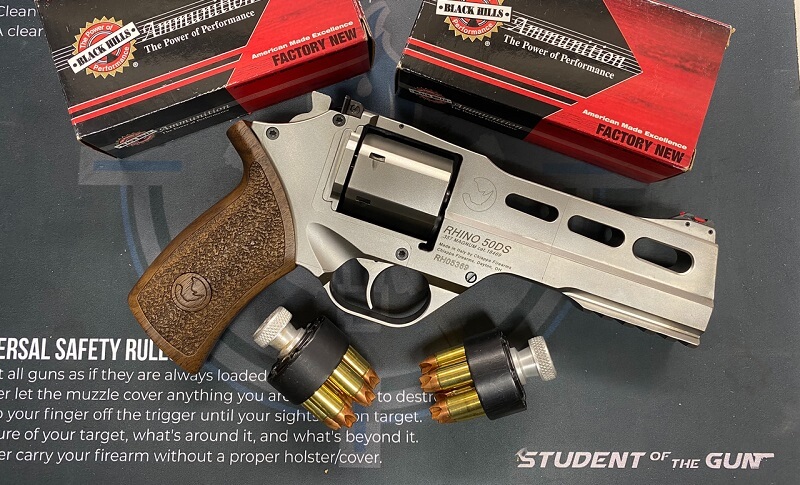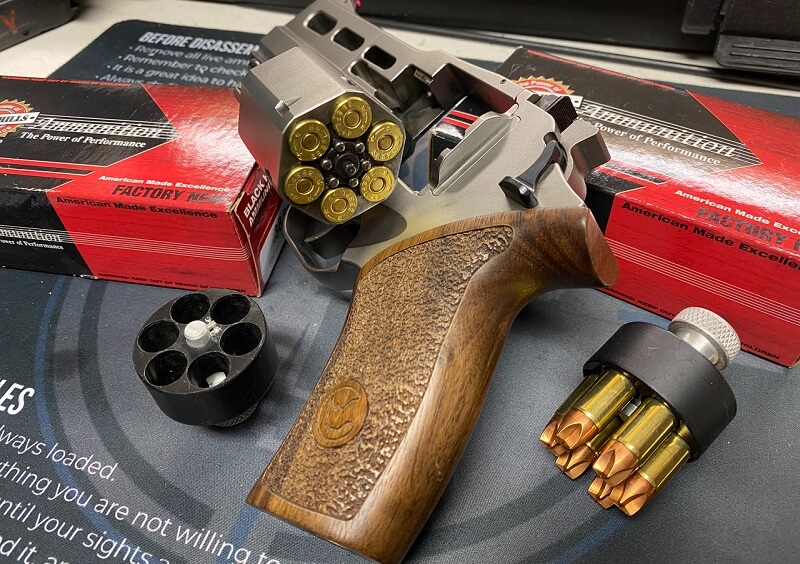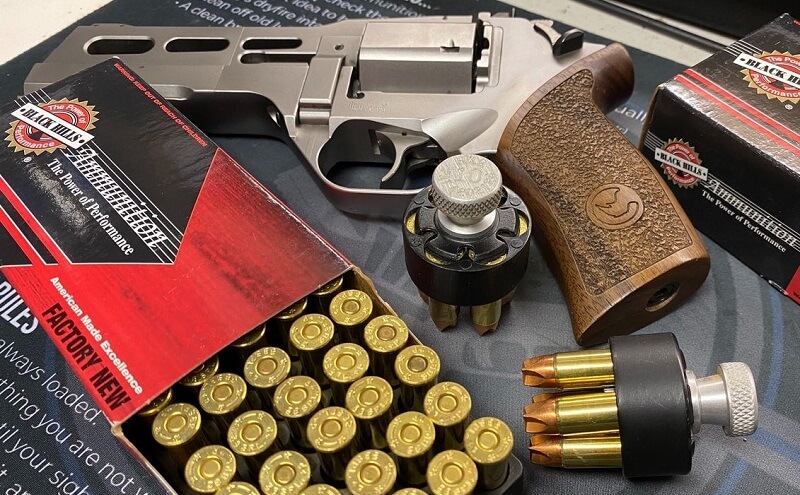Navigate This Post
It was not that long ago that Chiappa Firearms turned the handgun world on its head when it released the Rhino double-action revolver. In case you have not been paying much attention to the wheelgun world, the Rhino is a DA revolver imported from the Italian firearms maker. Today, we’re going to be reviewing it.
The Rhino revolvers come in numerous barrel lengths, grip styles, finishes and even calibers. The model that we will be reviewing for this article is the Model 50DS. It is a .357 Magnum with a 5 inch barreled, brushed stainless steel finish with hardwood grips. Use the table of contents to navigate the article and make your life a bit easier.

The Chiappa Rhino 50DS in .357 Magnum.
How does Chiappa Rhino Work?
GET OUR FREE WEEKLY NEWSLETTER
The Chiappa Rhino 50DS is a six-shot, double-action revolver chambered in .357 Smith & Wesson Magnum. Yes, it will naturally accept .38 Special ammunition as well. The previous description will fit hundreds of handguns on the market, but that is where the Rhino parts ways from the norm. The six round cylinder rotates clockwise with the bottom or 6 o’clock chamber lining up with the forcing cone of the barrel. Unlike most every revolver on the planet, the barrel is at bottom (6 o’clock) not the top (12 o’clock). Why?
By placing the barrel low in the frame, Chiappa has aligned the recoil impulse as close to the center-line of the grip and forearm of the shooter as possible. The majority of the recoil impulse goes straight back into the strongest part of the grip, as opposed to a normal DA revolver that puts the recoil impulse at the top of the shooter’s grip.
The design effectively dampens the felt recoil of the gun. Simultaneously, it allows the shooter to get back on target much faster than with conventional DA revolvers. This is particularly true when firing genuine, full-strength .357 Magnum ammunition. A small design decision, but one with a massive impact on the weapon system.
How the Action Functions and Feels.
While the action of the Rhino is a familiar DA, the mechanism is much more advanced than your standard off the shelf wheelgun. Those who are used to a heavy trigger that stacks (gets heavier as you press), the Chiappa Rhino will surprise you. Rather than stack and get heavier until the breaking point where the firing pin releases, the Rhino’s trigger is consistent and the let off is to the point where it is almost a surprise. This is one of those you have to try to truly understand situations. However, trust me, if you are used to your trigger finger aching from pulling a super-heavy, lawyer friendly DA trigger, you are going to like the Rhino.
You can fire the Rhino with a single-action trigger press by pulling back on the exposed hammer mechanism. The hammer is really just a cocking mechanism as it is separate from the actual firing pin. After you cock the gun for single-action, the “hammer” resets against the frame but the trigger is set. If this sounds a bit strange for a wheelgun, it is, but it works.

The Rhino is a 6-shot, double-action revolver.
Where to buy a Chiappa Rhino?
Of course, as I type these words, these are not “normal” times. During normal times, I would say just go to one of any number of online retailers and order a Rhino shipped to you local FFL guy. Sources like, www.Guns.com, www.Brownells.com, and www.gunbroker.com under normal circumstances would have them in stock. If you want a Rhino, you are going to have to be diligent and search around. If you’re on this review a couple weeks after the election though, check above. You’ll be alright.
How much should I expect to pay for a Rhino? Good question. These guns are not made cheaply. Therefore they are not priced cheaply. You can expect to pay somewhere between $1000 and $1500 for a Rhino, depending on the barrel length and other features.
Range Time with the Chiappa Rhino.
I have owned the Rhino 50DS for a while and I must confess that it has taken a backseat to all of the newer, polymer-framed Wonder-Nines that have come out lately. My experience with the Rhino revolvers dates back several years, but it was time to knock off the dust and burn some powder. Sometimes, you just need a day to shoot wheelguns.
My range ammo can was filled with a variety of .38 Special and .357 Magnum ammunition. Notably, I would shoot the new .38 Spl Honeybadger ammo from Black Hill Ammunition and a .357 Magnum 125 grain JHP load from that same company.
As the forcing cone of the barrel on the Chiappa Rhino is located at the bottom, not the top, the shooter is advised to mind their grip. Many shooters who spend all their time firing automatic pistols will allow their support hands to move forward on the frame. You can get away with that when using an auto, but not with the Rhino. A considerable amount of burning gas escapes from the gap between the cylinder and the forcing cone. Your hand does not belong there.
To reload the Rhino revolver quickly, I packed out a couple of HKS Model 10 speed-loaders that I have had for at least 20 years. While they were made for the S&W Model 10, they work just fine for the six shot Rhino. Just a side-note for any would-be purchasers. These things are awesome, and you definitely need them.

The Author used a variety of .38 Special and .357 Magnum ammunition. Including the Black Hills Honeybadger in .38 Spl and a full powered .357 Mag load
Range Work and More.
Initially, I worked out on steel targets from MGM Targets at distances of five to ten yards. As mentioned earlier, the double-action trigger press of the Chiappa Rhino is exceptional and the felt recoil and muzzle flip is minimal.
Moving farther away from the targets, I found that I needed to change the elevation setting at the rear sight. This didn’t become a serious issue until about the 30 yard line. It was easy to do with a flat-head screwdriver. By applying two clicks “down” on the rear sight, hitting steel silhouettes became reliable back to 45 yards.
During my most recent range session I fired about 180 rounds combined between the .38 Spl and the .357 Mag. While that might not sound like a lot, when you are only shooting six at a time between reloads, a couple hundred rounds takes a while. Considerably longer than shooting the same amount of ammunition through a magazine fed platform.
Parting Thoughts on the .357 Chiappa Rhino.
Before you ask, yes the Rhino 50DS was accurate. As will most modern firearms, the gun possess more inherent accuracy than the majority of shooters can realize. I started my range session with a cleaned, well-lubricated gun and I had no troubles with it. Like most all revolvers, the gun had a noticeable amount of carbon after my range session. That cleaned up quickly thanks to the stainless steel finish and the previous application of lube.
As for the retail price of the Rhino, before you complain, you might compare it to a comparable firearm. The S&W 686 from the Performance Center will cost you over $1000. The technology and intelligent engineering built into the Chiappa Rhino pistols make them sought after firearms. If you are looking for a quality DA revolver, that is a pleasure to shoot, even with Magnum loads, take a serious look at the Rhino. You will not regret the purchase.
Professor Paul Markel
Latest posts by Professor Paul Markel (see all)
- Tactical Rifle Tips: Transition Drills - January 5th, 2024
- 40/20/25 Shooting Drill - October 29th, 2023
- Working With Your Body Armor - October 3rd, 2023
- Hi-Point YC9: Yeet Cannon - August 14th, 2023
- Texas Hog Hunting: Day or Night w/ One Rifle - July 25th, 2023
Trackbacks/Pingbacks